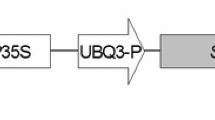Abstract
Genetic analysis was done on a number of nitrate tolerant supernodulating (nts) mutant soybean lines. These lines are altered in the autoregulation response, and each was isolated as a separate mutational event following chemical mutagenesis. Crosses were made betweennts lines on a diallel pattern, and each was also crossed usingnts lines as female parent, to wild-type nodulation cultivars. F1 and F2 data were analysed from each cross for nodulation type and number. No complementation was noted wherents lines were intercrossed, suggesting that in each line the same gene was affected. Wherents lines were crossed with wild-type cultivars all the F1 progeny were wild-type, confirming that thenls gene is recessive and, with one exception,nts 1116, all of the F2 progeny segregated into a 3:1 wild-type to supernodulating phenotype, indicating that a single gene is involved. The hypernodulating linents 1116 gave a 1:1 ratio in its F2 progeny when crossed with othernts lines. This line behaved as a dominant in the latter crosses. No wild-type segregants were recovered, therefore again no complementation look place. This line may be a leaky mutant with partial autoregulation as its segregation ratios do not fall into any of the obvious patterns.
Similar content being viewed by others
References
Carroll B J, McNeil D L and Gresshoff P M 1985a Isolation and properties of soybean (Glycine max) mutants that nodulatc in the presence of high nitrate concentrations.Proc. Natl. Acad. Sci. USA 82: 4162–4166
Carroll B J, McNeil D L and Gresshoff P M 1985b A supernodulation and nitrate tolerant symbiotic (nts) soybean mutant.Plant Physiol. 78: 34–40
Carroll B J, Gresshoff P M and Delves A C 1987 Inheritance of supernodulation in soybean and an estimation of the genetically effective cell number.Theor. Appl. Genet. (submitted)
Davies T M, Foster K W and Phillips D A 1985 Non-nodulation mutants of chick-pea.Crop Sci. 25: 345–348
Delves A C, Mathews A, Day D A, Carter A S, Carroll B J and Gresshoff P M 1986 Regulation of the soybean-Rhizobium nodule symbiosis by shoot and root factors.Plant Physiol. 82: 588–590
Gresshoff P M and Delves A C 1986 Genetic approaches to symbiotic nodulation and nitrogen fixation. InPlant gene research (eds) A D Blonstein and P J King (Vienna: Springer-Verlag) vol. 3, pp. 159–206
Jacobsen E and Feenstra W J 1984 A new pea mutant with efficient nodulation in the presence of nitrate.Plant Sci. Lett. 33: 327–334
Kosslak R M and Bohlool B B 1984 Suppression of nodule development of one side of a split root system of soybeans caused by prior inoculation of the other side.Plant Physiol. 75: 125–130
La Rue T A, Kneen B E and Gartside E 1985 Plant mutants defective in symbiotic nitrogen fixation. InAnalysis of the plant genes involved in the legume-Rhizobiwn symbiosis (Paris: OECD Publ.) pp. 39–49
Pierce M and Bauer W D 1983 A rapid regulatory response governing nodulation in soybean.Plant Physiol. 73: 286–290
Author information
Authors and Affiliations
Rights and permissions
About this article
Cite this article
Delves, A.C., Carroll, B.J. & Gresshoff, P.M. Genetic analysis and complementation studies on a number of mutant supernodulating soybean lines. J. Genet. 67, 1–8 (1988). https://doi.org/10.1007/BF02927732
Received:
Issue Date:
DOI: https://doi.org/10.1007/BF02927732




